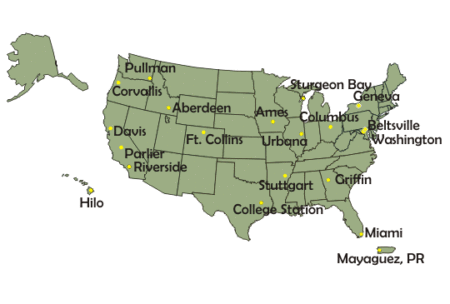- Remembering Robin Graham, prophet of biofortification.
- Honouring plant breeder supreme Fred Blisss.
- Need to produce seed of all those new varieties that breeders come up with.
- And save the stuff they will replace: The Economist does the potatoes of Chiloé.
- Hey, it’s not just about the crops: conserving goats on farm in India.
- The experimental archaeology of bread thrives under corona. And if you were intrigued by the potato detoxification reference, find the details on Bill Schindler’s website. And not only bread and potatoes, also beer…
- Like Mozart’s oat beer? Which was apparently killed off by lager back in Austria but is now available in Denver.
- Food shouldn’t be cheap, it should be affordable, and not only for those who consume it. Ancient Egyptian bread will be exempted.
- No way Kenyan coffee can be described as cheap. h/t Jeremy’s newsletter: have you subscribed yet?
- I don’t know how cheap mungbean is in Myanmar, but it seems to be very valuable.
- The PNG singing dog is not extinct in the wild after all? Priceless.
- Combination of key and photo guide to the identification of European fungi. Worth its weight in truffles. Source.
PGR Newsletter redux
Conceived to fill the gaps left by the discontinuation of the journals Plant Genetic Resources Newsletter and Animal Genetic Resources, it aims at serving the genetic resources community worldwide and across sectors.
That would be the new journal Genetic Resources, the first issue of which has just come out. I loved the old PGR Newsletter, and I’m really glad to see its baton passed on. The new journal’s website links to the archives of its predecessors.
Brainfood: Torres bananas, European Neolithic, Pleistocene dogs, Thai Neolithic, Amaranth domestication, Gluten trends, Perennial cereal, Resistant potatoes, Aridamerica, Ex situ mammals, AI, Zoonoses, Trade & diversity
- Multidisciplinary evidence for early banana (Musa cvs.) cultivation on Mabuyag Island, Torres Strait. Early as in 2000 years ago, which isn’t all that early compared to PNG. But opens possibility of mainland Aborigines being agriculturalists too, at least in the wet tropical NE.
- Climate shaped how Neolithic farmers and European hunter-gatherers interacted after a major slowdown from 6,100 BCE to 4,500 BCE. There was the most interaction between the two groups where Middle Eastern crops came to the limit of their climatic adaptation.
- The first evidence for Late Pleistocene dogs in Italy. Those hunter gatherers had dogs.
- Three thousand years of farming strategies in central Thailand. Millet first, then rice, but initially still rainfed. No word on whether anyone had dogs.
- Parallel Seed Color Adaptation during Multiple Domestication Attempts of an Ancient New World Grain. 3 grain amaranth domesticated species from one wild ancestor, with selection for white seeds in common.
- Wheat (Triticum aestivum L.) Breeding from 1891 to 2010 Contributed to Increasing Yield and Glutenin Contents but Decreasing Protein and Gliadin Contents. No evidence of increasing immunostimulatory potential in German wheat varieties.
- ‘MN‐Clearwater’, the first food‐grade intermediate wheatgrass (Kernza perennial grain) cultivar. Perennial is good, sure, but is it low in gluten?
- Screening of wild potatoes identifies new sources of late blight resistance. All plants in about 10% of 384 wild potato accessions were resistant.
- An Aridamerican model for agriculture in a hotter, water scarce world. 17 genera have highest potential to be used in polyculture to improve agricultural resilience, human health, and community prosperity in the face of climate change.
- Ex situ management as insurance against extinction of mammalian megafauna in an uncertain world. Fancy maths can tell you were genebanks could do the most good.
- Machine learning: A powerful tool for gene function prediction in plants. Very fancy maths can help you predict phenotype from genotype, and much more besides.
- Zoonotic host diversity increases in human-dominated ecosystems. Oh we are in so much trouble.
- Global changes in crop diversity: Trade rather than production enriches supply. Well, actually, a bit of both.
Genebank data update
I’ve decided to promote a couple of Nibbles from Monday to a full post. Because they’re important and I don’t want them to get overlooked, and I just don’t know how many people actually work through all the Nibbles. Maybe I should have led with these.
Anyway, the thing is, the USDA’s National Plant Germplasm System has just launched its new GRIN-Global webpage. 1 Through it, you can search for, and order, material from any of the system’s constituent genebanks. Of which there are, you know, a lot.

Now, don’t @ me if what you see there is not exactly the same as what’s in Genesys. They’ve been somewhat preoccupied in Beltsville, but we hope to get an update of their data very soon now. 2
Meanwhile, the potato-breeding machine that is Cultivariable has started publishing his latest evaluation data on (some of) the USDA’s potato germplasm (click on “Evaluation Year” and choose “2020”).
But will it find its way into any of the above-mentioned databases?
Maybe.
Nibbles: Hambre, Potato song, Blockchain, Pacific crops, Botanic gardens
- Vavilov in Spanish.
- Song about the potato Solanum ajanhuiri from Aymara to Spanish to English.
- Using blockchain to trace biofortified seeds. Maybe.
- Vincent Lebot on the opportunity that Covid-19 represents for traditional Pacific crops. Silver lining.
- Botanic gardens to the rescue. Wouldn’t that be cool.